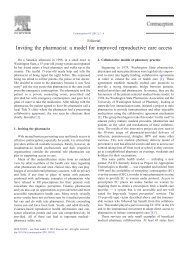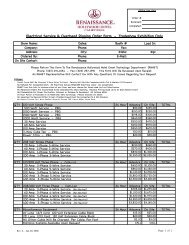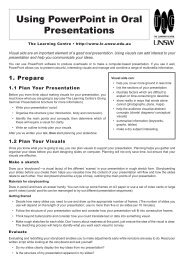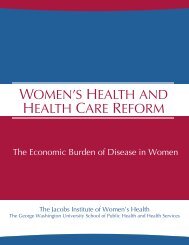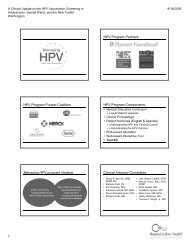Managing Premenstrual Symptoms - Association of Reproductive ...
Managing Premenstrual Symptoms - Association of Reproductive ...
Managing Premenstrual Symptoms - Association of Reproductive ...
You also want an ePaper? Increase the reach of your titles
YUMPU automatically turns print PDFs into web optimized ePapers that Google loves.
The doses <strong>of</strong> SSRIs needed to treat PMS are typically lower than<br />
those used to treat depression and anxiety. 23 Table 4 shows the<br />
recommended doses <strong>of</strong> various SSRIs for the treatment <strong>of</strong><br />
premenstrual disorders. Intermittent treatment is recommended,<br />
either during the luteal phase or on symptom days only. 2<br />
Other Serotonergic Agents<br />
Agents such as venlafaxine and clomipramine are also <strong>of</strong>ten used to<br />
treat PMDD. 25 These agents inhibit the serotonin transporter as well as<br />
the uptake <strong>of</strong> norepinephrine and may be beneficial for some women<br />
who do not respond to or tolerate the “pure” SSRIs. 2,15 Adding<br />
bupropion (a nonserotonergic agent) to a serotonergic antidepressant<br />
can boost antidepressant efficacy without increasing side effects such<br />
as orgasmic dysfunction. Nonserotonergic antidepressants, however,<br />
have not specifically been found to be effective in treating PMS. 2<br />
Oral Contraceptives<br />
The use <strong>of</strong> oral contraceptives (OCs) reduces dysmenorrhea ,<br />
intensity and duration <strong>of</strong> menstrual flow. Because premenstrual<br />
symptoms occur almost exclusively in ovulatory cycles, inhibiting<br />
ovulation could be expected to reduce or eliminate these<br />
symptoms. 26 Hormonal contraceptives that suppress ovulation,<br />
including the pill, patch, vaginal ring, and depotmedroxyprogesterone<br />
acetate (DMPA) injections, <strong>of</strong>fer effective<br />
relief from premenstrual symptoms for many women.<br />
20<br />
Because women using OCs for PMS <strong>of</strong>ten experience symptoms<br />
during the hormone-free interval, the selected treatment strategy<br />
should minimize or eliminate the hormone-free interval. Women<br />
may use monophasic OCs continuously, omitting the 7-day inert<br />
pills and starting a second pack immediately after the last active pill<br />
<strong>of</strong> their current pack. This regimen is safe and can be used<br />
indefinitely. Extended-regimen OCs, which are packaged with 84<br />
days <strong>of</strong> active treatment with a 7-day pill-free interval (e.g.,<br />
Seasonale ® , Seasonique ® ), or continuous OC regimens (Lybrel ® )<br />
may decrease hormone withdrawal symptoms, which include<br />
menstrually related headaches, cyclic mood swings, pelvic pain,<br />
and dysmenorrhea. Unscheduled bleeding is common during<br />
extended or continuous use <strong>of</strong> OCs. Provided that the patient has<br />
used OC tablets for a minimum <strong>of</strong> the last 21 days, taking a 3-day<br />
break from OC use and then resuming their use can reduce future<br />
<strong>Managing</strong> <strong>Premenstrual</strong> <strong>Symptoms</strong> June 2008



